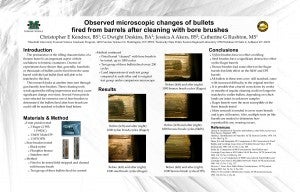Observed Microscopic Changes of Bullets Fired from Barrels after Cleaning with Bore Brushes
Biography:
Chris Kendrex is from Hammonton, NJ, and graduated from Villanova University with a Bachelor of Science in Chemistry degree and a concentration in Biochemistry in 2007. He is working towards a Master of Science in Forensic Science degree at Marshall University with emphases in DNA Analysis, Forensic Chemistry, Digital Forensics, and Crime Scene Investigation. This summer, Chris completed an internship in the Firearms and Toolmarks section of the Kentucky State Police Eastern Lab.
Although it is considered common knowledge that using steel bore brushes to clean firearm barrels may have potential to change the pattern individual characteristics, no documentation of the effect is to be found in the literature. In an effort to confirm this effect, several 9mm semiautomatic pistols were field-stripped and their barrels subjected to a simulation of long-term use of various bore brushes. The results demonstrated that metal bore brushes have an ability to affect the land impressions. In most instances this appears to be through erosion, as fine striations were broadened and lowered by smoothing or obliterated entirely. Coarse marks were less likely to be affected. While steel brushes were most effective, the effect was also observed after cleaning with bronze brushes. While all final test fires could still be matched to the initial test fires, fewer areas of good correspondence were observed, and often an easy match became a difficult one with only one or two lands having sufficient striations remaining. In addition, the effect appeared somewhat random, with unequal results on particular land impressions within the same barrel. It is conceivable that with some firearms, this change in the individual characteristics could render the entire bullet unmatchable to an earlier-fired bullet. Further research needs to be done to see what types of firearms are most affected by this technique and if there is any correlation between the method of barrel manufacture and how efficacious the bore brushes are at affecting the individual characteristics of the barrel.
Poster:
References:
- Heard, B. Handbook of Firearms and Ballistics. John Wiley & Sons Ltd. West Sussex, England. 1997.
- Hamby, J. Identification of Proectiles. AFTE Journal. October, 1974. Vol. 6, No. 5&6, Pg. 22.
- Shem, R.J. and Striupaitis, PP. Comparison of 501 Consecutively Fired Bullets and Cartridge Cases from a 25 Caliber Raven Pistol. AFTE Journal. July 1983. Vol. 15, No. 3, Pg. 109.
- Kirby, S.J. Comparison of 900 Consecutively Fired Bullets and Cartridge Cases from a 455 Caliber S & W Revolver. AFTE Journal. July 1983. Vol. 15, No. 3, 1983, Pg. 113.
- Ogihara, Y. et al. Comparison of 5000 Consecutively Fired Bullets and Cartridge Cases from a 45 Caliber M1911A1 Pistol. AFTE Journal. July, 1983. Vol. 15, No. 3, Pg. 127.
- Meyers, C. Some Basic Bullet Striae Considerations. AFTE Journal. Spring 2002. Vol. 34, No. 2, Pg. 158.
- Miller, B. Preventative Maintenance Guide, AFTE Journal. January, 1993. Vol. 25, No. 1, Pg. 40.
- Nichols, R.G. Consecutive Matching Striae (CMS): Its Definition, Study and Application in the Discipline of Firearms and Tool Mark Identification. AFTE Journal. Summer, 2003. Vol. 35, No. 3, Pg. 298.
- Nichols, R.G. Defending the Scientific Foundations of the Firearms and Tool Mark Identification Discipline: Responding to Recent Challenges. Journal of Forensic Sciences. May 2007. Vol. 52, Issue 3, Pg. 586.
